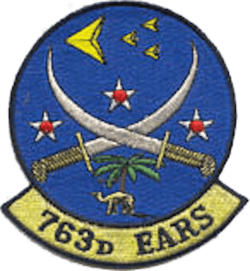763d Expeditionary Air Refueling Squadron
| 763d Expeditionary Air Refueling Squadron | |
|---|---|
|
Emblem of the 763d Expeditionary Air Refueling Squadron | |
| Active |
1943–1945 1998–2003 |
| Country | United States |
| Branch | United States Air Force |
| Type | Bombardment |
The 763d Expeditionary Air Refueling Squadron is a provisional United States Air Force unit. It was last known to be assigned to the 363d Air Expeditionary Operations Group, Al Dhafra Air Base, United Arab Emirates. The 363 AEOG was inactivated on 26 August 2003. The squadron's current status is undetermined.
The World War II 763d Bombardment Squadron was a B-24 Liberator heavy bombardment squadron, last assigned to the 460th Bombardment Group, which was stationed at Natal Airport, Brazil.
It was inactivated on 26 September 1945.
History
Activated as a B-24 Liberator heavy bomber squadron in mid-1943, it was assigned to II Bomber Command. It was primarily trained in New Mexico and Utah. The unit received deployment orders for the Mediterranean Theater of Operations (MTO) in August 1943. It first moved to Georgia and Virginia, where the squadron flew coastal patrol missions over the southeast US, between October 1943 and January 1944 while its base in Italy was being constructed.
The squadron deployed to southern Italy and entered combat in January 1944, being assigned to the Fifteenth Air Force 55th Bombardment Wing. It was engaged in very long-range strategic bombing missions on enemy military, industrial and transportation targets in Italy, France, Germany, Austria, Hungary, Romania and Yugoslavia. It bombed railroad marshalling yards, oil refineries, airdrome installations, heavy industry and other strategic objectives.
The squadron flew its last World War II combat mission on 26 April 1945. After V-E Day, it was assigned to the 'Green Project', the movement of troops from Europe to the United States via the South Atlantic transport route. B-24s were modified with sealed bomb bays, the removal of all defensive armament and the fuselage was equipped with seating to carry approximately 30 personnel. It was assigned to Air Transport Command at Waller Field, Trinidad and to Natal, Brazil. It moved personnel from Dakar in French West Africa, where personnel were conveyed across the South Atlantic to Brazil and eventually to Morrison Field, Florida via Trinidad. The squadron provided air transport until the end of September when it was inactivated.
The squadron was reactivated by a re-designation of the 4413th Air Refueling Squadron, Provisional, on 1 December 1988. Its mission was to provide combat refueling of Coalition aircraft assigned to United States Air Forces Central, primarily as part of Operation Southern Watch. It supported Operation Enduring Freedom beginning in 2002, and Operation Iraqi Freedom in 2003. Its host unit, the 363 AEOG, was inactivated on 26 August 2003 with the closing of United States facilities at Prince Sultan Air Base, Saudi Arabia.
Lineage
- Constituted as the 763d Bombardment Squadron (Heavy) on 19 May 1943
- Activated on 1 July 1943
- Inactivated on 26 September 1945
- Redesignated as the 763d Expeditionary Air Refueling Squadron and converted to provisional status on 1 December 1988.
- Activated by redesignation of 4413th Air Refueling Squadron, Provisional, 1 December 1988
- Possibly inactivated on 23 August 2003
Assignments
- 460th Bombardment Group, 1 July 1943 – 26 September 1945
- Attached to Air Transport Command, 15 June – 26 September 1945
- Air Combat Command, 1 Dec 1988 – ?
- Attached to United States Air Forces Central
- Further attached to 363d Air Expeditionary Operations Group
Stations
- Alamogordo Army Air Field, New Mexico, 1 July 1943
- Kearns Center, Utah, 31 August 1943
- Chatham Army Airfield, Georgia, 29 October 1943 – 3 January 1944
- Spinazzola Airfield, Italy, c. 11 February 1944 – 6 June 1945
- Waller Field, Trinidad, 15 June 1945
- Natal Airport, Brazil, 30 June – 26 September 1945
- Al Dhafra Air Base, United Arab Emirates, 1 Dec 1988 – ?
Aircraft
- B-24 Liberator, 1943–1945
- KC-135 Stratotanker, 1998–?
References
![]() This article incorporates public domain material from the Air Force Historical Research Agency website http://www.afhra.af.mil/.
This article incorporates public domain material from the Air Force Historical Research Agency website http://www.afhra.af.mil/.
- Maurer, Maurer, ed. (1982) [1969]. Combat Squadrons of the Air Force, World War II (PDF) (reprint ed.). Washington, DC: Office of Air Force History. ISBN 0-405-12194-6. LCCN 70605402. OCLC 72556.
